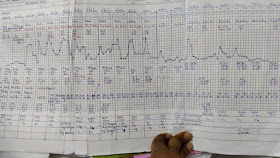Paraparesis case 1
My case is paraparesis
For Original details of case click below link
https://srianugna.blogspot.com/2020/05/hello-everyone.html
Cheif complaints
Bilateral lower limb weakness since 20 days
Started proximal later progressed to bilateral distal region
Bilateral edema which is non pitting
Difficulty in squatting and getting up
Difficulty in wearing chepals
NO H/O DIFFICULTY IN COMBING HAIR , BUTTONING AND UNBUTTONING SHIRT
NO H/O CRANIAL NERVE INVOLVEMENT
According to me
Neurological weakness due to
1. Upper motor neuron
2. Basal ganglia and cerebellum
3. Lower motor neurons
Other causes of weakness might be
Systemic
Drug induced
Vitamin deficiency
Autoimmune diseases
Thyroid condition
We will rule out one by one so that we can come to conclude diagnosis
Upper motor neuron lesions means any lesion from cerebral cortex to
Spinal cord
Symptoms of upper motor lesion are
Hypertonia
Hyperreflexia
Exaggerated deep tendon reflexes
Babinski sign positive
No Loss of power
In our patient no symptoms and sign related to UMN lesion are present so we can rule out UMN lesion
Lesion of basal ganglia shows
Tremors
Rigidity
Akinesia
Posture instability
So in our patient above mentioned are not seen so we can rule out basal ganglia
Lesion of cerebellum
Cerebellar lesions symptoms are
Dysmetria
Ataxia
Nystagmus
Intention tremors
Hypotonia
Slurred speech
Above symptoms are not seen in our patient so we can rule out cerebellar lesion.
Lower motor lesion symptoms are
mostly proximal muscle are involved
atrophy of mucles
flaccidity
hypotonia
deep tendon reflexes are reduced or absent
babinski is negative
fasiculations and fibrillations are present
Lesion of LMN can be at four places on its pathway
Anterior horn cell
Peripheral nerve
NMJ
Muscle (myopathy)
Lesion of anterior horn cell can be ruled out by
To rule out Anterior horn cell disease and peripheral neuropathy , evaluation of conduction velocity (NCV), histological findings , biochemical studies are necessary.
NCV testing has to be done in the patient , which helps us to know whether it is neurogenic.
ELECTROMYOGRAPHY is done and showing normal results , from which we can rule out NMJ disorders.
To rule out thyroid, thyroid profile should be done
According to the history
There is bilateral calf hypertrophy which is a classical sign of x linked muscular dystrophy
DMD vs BMD
So as DMD appears in early childhood and life expectancy is mid 20s we can rule out DMD
Investigation
Treatment for BMD
There is no cure, but treatments are available to help with symptoms and maximize muscle function. It is vital that a person with BMD stay in shape and continue to use their muscles. This can include physical therapy. Treatment can also include genetic counseling, using splints, massages, and catabolic steroids.








Comments
Post a Comment